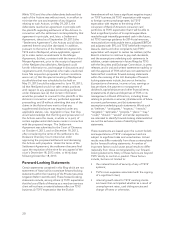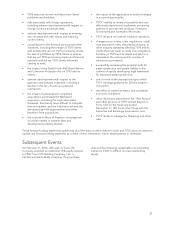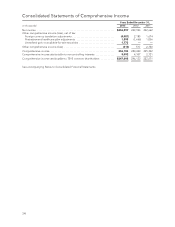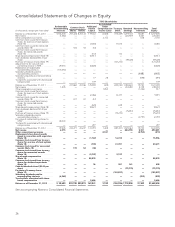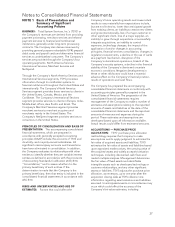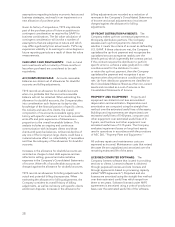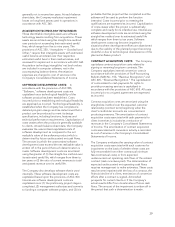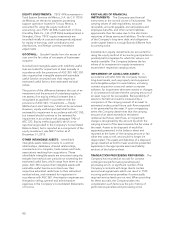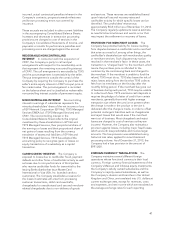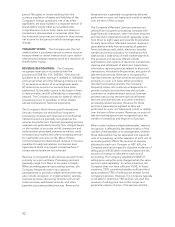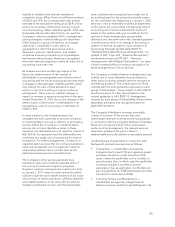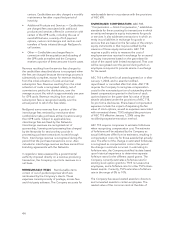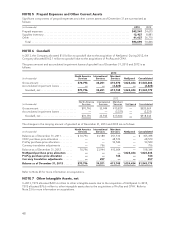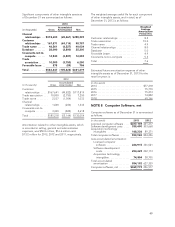NetSpend 2013 Annual Report Download - page 41
Download and view the complete annual report
Please find page 41 of the 2013 NetSpend annual report below. You can navigate through the pages in the report by either clicking on the pages listed below, or by using the keyword search tool below to find specific information within the annual report.generally not to exceed ten years. At each balance
sheet date, the Company evaluates impairment
losses on long-lived assets used in operations in
accordance with ASC 360.
ACQUISITION TECHNOLOGY INTANGIBLES:
These identifiable intangible assets are software
technology assets resulting from acquisitions. These
assets are amortized using the straight-line method
over periods not exceeding their estimated useful
lives, which range from five to nine years. The
provisions of ASC 350, “Intangibles — Goodwill and
Other,” require that intangible assets with estimated
useful lives be amortized over their respective
estimated useful lives to their residual values, and
reviewed for impairment in accordance with ASC 360.
Acquisition technology intangibles’ net book values
are included in computer software, net in the
accompanying balance sheets. Amortization
expenses are charged to cost of services in the
Company’s Consolidated Statements of Income.
SOFTWARE DEVELOPMENT COSTS: In
accordance with the provisions of ASC 985,
“Software,” software development costs are
capitalized once technological feasibility of the
software product has been established. Costs
incurred prior to establishing technological feasibility
are expensed as incurred. Technological feasibility is
established when the Company has completed a
detailed program design and has determined that a
product can be produced to meet its design
specifications, including functions, features and
technical performance requirements. Capitalization of
costs ceases when the product is generally available
to clients. At each balance sheet date, the Company
evaluates the unamortized capitalized costs of
software development as compared to the net
realizable value of the software product which is
determined by future undiscounted net cash flows.
The amount by which the unamortized software
development costs exceed the net realizable value is
written off in the period that such determination is
made. Software development costs are amortized
using the greater of (1) the straight-line method over
its estimated useful life, which ranges from three to
ten years or (2) the ratio of current revenues to total
anticipated revenue over its useful life.
The Company also develops software that is used
internally. These software development costs are
capitalized based upon the provisions of ASC 350.
Internal-use software development costs are
capitalized once: (1) the preliminary project stage is
completed, (2) management authorizes and commits
to funding a computer software project, and (3) it is
probable that the project will be completed and the
software will be used to perform the function
intended. Costs incurred prior to meeting the
qualifications are expensed as incurred. Capitalization
of costs ceases when the project is substantially
complete and ready for its intended use. Internal-use
software development costs are amortized using the
straight-line method over its estimated useful life
which ranges from three to ten years. Software
development costs may become impaired in
situations where development efforts are abandoned
due to the viability of the planned project becoming
doubtful or due to technological obsolescence of the
planned software product.
CONTRACT ACQUISITION COSTS: The Company
capitalizes contract acquisition costs related to
signing or renewing long-term contracts. The
Company capitalizes internal conversion costs in
accordance with the provisions of Staff Accounting
Bulletin (SAB) No. 104, “Revenue Recognition” and
ASC 605, “Revenue Recognition.” The capitalization
of costs related to cash payments for rights to
provide processing services is capitalized in
accordance with the provisions of ASC 605. All costs
incurred prior to a signed agreement are expensed
as incurred.
Contract acquisition costs are amortized using the
straight-line method over the expected customer
relationship (contract term) beginning when the
client’s cardholder accounts are converted and
producing revenues. The amortization of contract
acquisition costs associated with cash payments for
client incentives is included as a reduction of
revenues in the Company’s Consolidated Statements
of Income. The amortization of contract acquisition
costs associated with conversion activity is recorded
as cost of services in the Company’s Consolidated
Statements of Income.
The Company evaluates the carrying value of contract
acquisition costs associated with each customer for
impairment on the basis of whether these costs are
fully recoverable from either contractual minimum
fees (contractual costs) or from expected
undiscounted net operating cash flows of the related
contract (cash incentives paid). The determination of
expected undiscounted net operating cash flows
requires management to make estimates. These costs
may become impaired with the loss of a contract, the
financial decline of a client, termination of conversion
efforts after a contract is signed, diminished
prospects for current clients or if the Company’s
actual results differ from its estimates of future cash
flows. The amount of the impairment is written off in
the period that such a determination is made.
39



